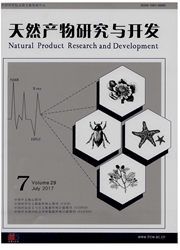

 中文摘要:
中文摘要:
采用95%乙醇对甘遂进行提取,溶剂回收后得总浸膏;然后采用不同极性的有机溶剂进行萃取得萃取物;将总浸膏和各萃取物进行激活NF—KB信号通路活性检测;选取激活作用最强的氯仿萃取物进行硅胶柱层析,TLC检测合并;将得到的各部位进行进一步的激活NF—KB信号通路测试;结果表明激活作用最强的部位为非极性部位,因此我们采用GC—MS技术分离并鉴定了56个化合物,占总量的99.72%,主要成分为脂肪酸及其衍生物、长链烷烃及其衍生物,还有单萜、倍半萜类、芳香族类和脂肪醛等。在激活NF—KB信号通路的指导下,我们从甘遂非极性部位分析并鉴定了其中的促炎成分如(z)-7-Hexadecenal和7,11-Hexadecadienal等,这些成分激活NF.KB信号通路的表达,从而引起炎症因子的释放,导致炎症,从上述非极性部位中还分析了部分毒性物质,为阐明甘遂的毒效物质基础提供了参考。
 英文摘要:
英文摘要:
Kansui Radix, the dried roots of Euphorbia kansui Liou. (Euphorbiaceae), are commonly used traditional Chi- nese medicine. It was reported that the usage of Kansuiwould cause inflammation. An NF-KB-Luc reporter system was es- tablished to evaluate the bioactivity of Kansuiin this study. The 95% ethanol crude extractand different solvent-soluble extracts of Kansui were obtained by solvent extraction and fractionation. Bioassay guided separation suggested that the first sub-fraction ( C1 ) of the CHC13-soluble fraction displayed strong bioactivity. GC-M$ was introduced to separate and identify the chemical components of the nonpolar sub-fraction of Kansui ( C1 ). Totally 56 compounds were identified from the non-polar sub-fraction C1. The main components were aliphatie acids and derivatives, long-chain alkanes, monoterpenes, sesquiterlenes, aromatic eompoundsand aldehydydes. The aliphatic aldehydes such as (Z)-7-hexadecenal and 7,11-hexadecadienal detected in the sample extract were reported to cause inflammation. Some aromatic compounds were tumorigenic agents. The results in this paper provided a clue for the further investigation of toxic substances in Kansui.
 同期刊论文项目
同期刊论文项目
 同项目期刊论文
同项目期刊论文
 期刊信息
期刊信息
